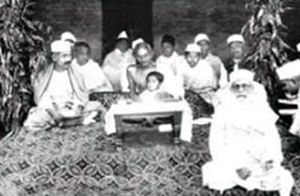Ahmedabad, Oct 9: "My life is my message", said Mahatma Gandhi. And one of Bapu's original disciples, Abdul Hamid Kureshi, 89 -the chair man of the Sabarmati Ashram - has enclosed a message in his death. Kureshi, who was also an eminent lawyer, chose to be cremated and not buried.
Kureshi breathed his last at the breakfast table in his residence in Swastik Society, Navrangpura, on Saturday morning. Sabarmati Ashram was the cradle of Bapu's revolutionary ideas to win freedom from the British.
It was a rare sight at the Mukti Dham crematorium in Paldi where Kureshi's illustrious family gathered for his final rites. Senior members of the higher judiciary and distinguished lawyers stood alongside the grieving family . Kureshi was the grandson of Imam Saheb Abdul Kadir Bawazir, a close associate of Bapu in South Africa.Bapu referred to Imam Bawazir as his "sahodar", brother born from the same mother.
"Kureshi saheb wished to be cremated because he did not want to waste land with his burial," said Bharat Naik, the sonin-law of Kureshi's brother, Wahid Kureshi. "In fact, he made me a witness to the decision in the presence of other family members." Over the past four years, Kureshi had been reminding his son, Justice Akil Kureshi, and Naik that they should ensure he is cremated. He asserted that if anyone objected, the person should be told of his last wish.Kureshi was cremated after 7 pm.
Kureshi was born in the Sabarmati Ashram in Ahmedabad where Imam Bawazir had settled with Bapu in 1915. Born in 1927, Kureshi grew up on Bapu's lap till Bapu embarked on the Dandi March in 1930. Kureshi was one of the few kids who ate tomato slices from Bapu's lunch. Bapu wrote letters to a young Kureshi, which were later donated to the National Archives of India.
"Kureshi's father, Ghulam Rasool, was part of `Arun Tukdi' that walked ahead of the Dandi March procession," said Sabarmati Ashram director Tridip Suhrud. "The team had to ensure that arrangements for meetings and halts were in place."
After Ghulam Rasool and his wife were arrested during the Dandi March, Abdul Hamid, his brother Wahid, and sister Sultana were brought up for a few years by Anasuya Sarabhai, said the secretary of the ashram, Amrut Modi. "Sarabhai was a Gandhian and pioneer of women's labour movement in India," he said. Rizwan Kadri, an Ahmedabad-based historian, said that in September1942 Kureshi was arrested in Detroj during the Quit India movement.
Kureshi became the chairman of the Sabarmati Ashram trust three years ago. A peace activist at heart, Kureshi worked to build bridges between Hindus and Muslims and penned a book titled " Agnipariksha" after the 1969 communal riots in Gujarat.





Comments
None can stop if any one wants to follow Sataan and enter Hell. I think this idiot deserves it. He did not agree to waste land but agree to pollute atmosphere thereby creating pollution. I am sure he was a follower of Satan and he will meet his Guru in the Hell.
Good muslim, doesn't want to meet 72 houris.
Add new comment